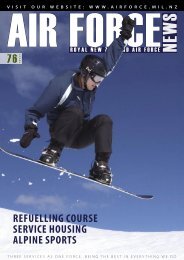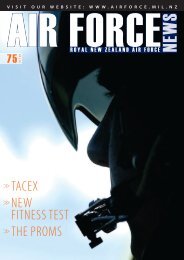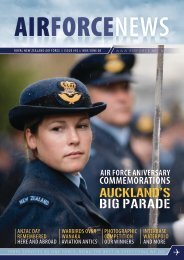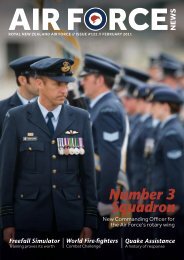June 2006, Issue 71 [pdf 2.8mb, 40 - Royal New Zealand Air Force
June 2006, Issue 71 [pdf 2.8mb, 40 - Royal New Zealand Air Force
June 2006, Issue 71 [pdf 2.8mb, 40 - Royal New Zealand Air Force
Create successful ePaper yourself
Turn your PDF publications into a flip-book with our unique Google optimized e-Paper software.
24<br />
SQNLDR Harley James observes a<br />
group of OASB candidates .<br />
AK 06-0142-18<br />
A candidate prepares to tackle the SMA-4.<br />
AK 06-0142-14<br />
with a distraction task) plays a signifi cant role in determining whether a<br />
candidate will be selected for pilot training. However, explains SQNLDR<br />
Emma Davis, the Director of <strong>Air</strong> <strong>Force</strong> Psychology, a candidate’s performance<br />
on the cognitive measures of pilot aptitude is equally important<br />
in assessing their suitability for fl ying training. The assessment by the<br />
psychologist for all branches explores their academic ability, branch<br />
motivation/orientation and personality suitability for the role they are<br />
applying for.<br />
‘The SMA-4 originates from the RAF and versions of the test continue to<br />
be used by a number of militaries around the world. The version used by<br />
the RNZAF is currently being upgraded with new hardware and software<br />
and should be ready for use at the next board in September’.<br />
For the next two days the candidates come under the watchful eye of<br />
two assessing offi cers (Team Offi cers – TO’s). TO’s come from all offi cer<br />
branches of the RNZAF and are comprised of senior fl ight lieutenants,<br />
squadron leaders and wing commanders. It is the TO’s role to assess<br />
the candidates in a range of different outdoor and indoor exercises<br />
and comment on observed behaviours against a list of dimensions. The<br />
dimensions include written and oral communication, relations with others,<br />
decision making, group infl uence, initiative, determination, stability under<br />
pressure and reasoning/planning ability. Each exercise is designed to test<br />
a range of dimensions across different scenarios.<br />
THE ROUND TABLE<br />
A group attemps to solve an outdoor exercise<br />
using only wood, rope and teamwork.<br />
AK 06-0142-19<br />
After the group assessment has been completed, TO and psychologist<br />
interviews are conducted. This completes the selection assessment for<br />
each candidate and the Director of Recruiting convenes a ‘Round Table’<br />
discussion. Civilian candidates are sent off to complete fi tness testing<br />
and the assessing psychologists and TO’s present their reports on each<br />
candidate. It is remarkable how close each assessment is considering<br />
that the TO’s and psychologists are basing their assessment of candidate<br />
performance on different measurement tools, says SQNLDR Sexton.<br />
‘The biggest and most common gap occurs when a candidate has not<br />
performed well in the aircrew aptitude tests. While the TO’s might highly<br />
recommend a candidate, the psychologists cannot recommend the candidate<br />
in this instance. These candidates are often considered for non-pilot<br />
roles or ground offi cers if they have the required qualifi cations’.<br />
BOARD CONCLUSION AND SELECTION<br />
The OASB is not the fi nal stage in the selection process. All candidates<br />
are interviewed by the Director of Recruiting and advised whether they<br />
have been successful at this stage of the selection process. For those<br />
who are not successful some feedback is provided and other enlistment<br />
options explored (if they are civilian candidates).<br />
AFN<strong>71</strong> JUNE 06 www.airforce.mil.nz


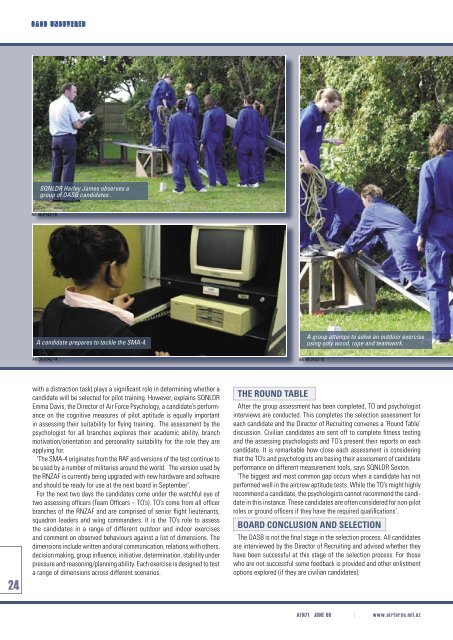
![February 2007, Issue 78 [pdf 3mb, 44 pages] - Royal New Zealand ...](https://img.yumpu.com/17485296/1/184x260/february-2007-issue-78-pdf-3mb-44-pages-royal-new-zealand-.jpg?quality=85)



